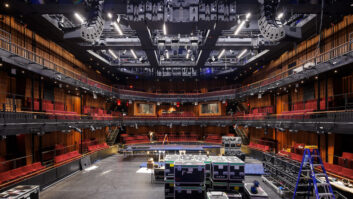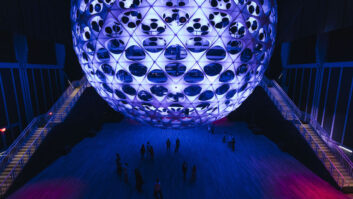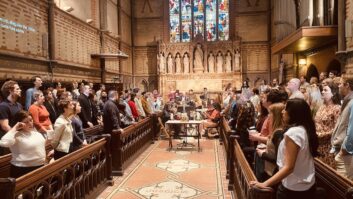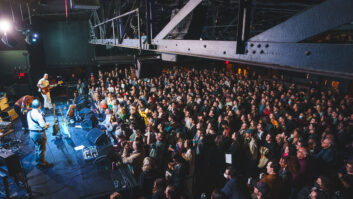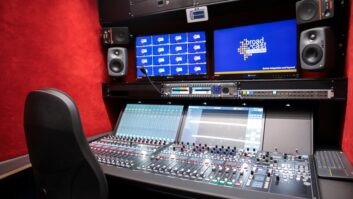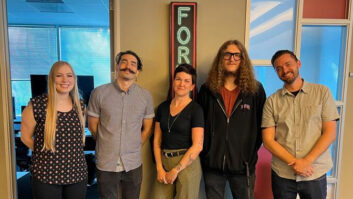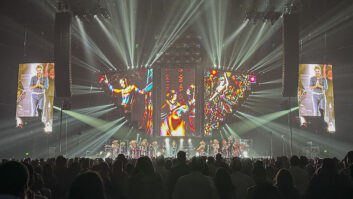Bill Daly, FOH engineer for Wheel Of Fortune (left), and Alan Henig, PRG audio project manager/system tech, prepare for another remote taping at New York’s Theater at Madison Square Garden.
New York, NY (May 30, 2013)��They say the only certainties in life are death and taxes, but you could add Wheel of Fortune to the list (it would make for a happier line-up, to be sure). For 30 years, Pat Sajak and Vanna White have hosted thousands of contestants on the classic game show, each visitor spinning the wheel and calling out letters in hopes of winning the high-tech game of Hangman. It’s a comfortable, timeless formula that’s perfect as-is, but a few times a year, the show adds a little spice by going on the road, taping 20 episodes on location in different cities around the country.

It’s no mere afterthought either—Wheel of Fortune always tapes from a notable venue in each city, creates a brand-new set just for those shows, and brings along its longtime audio team, which oversees sound reinforcement gear provided by PRG Audio (Orlando, FL). For each episode, FOH engineer Bill Daly, monitor engineer Bruce “BG” Glimpse and PRG Audio project manager/system tech Alan Henig ensure the live audience catches not just every word, but every letter.
The most recent location shoot took place in March, when Wheel of Fortune rolled into New York City, taping shows for May broadcast at the Theatre at Madison Square Garden, a 5,600-seat venue sandwiched between the famous arena above, and the busiest commuter railroad station in the country, Pennsylvania Station, below. While that could be the recipe for a rough production, between NBA games upstairs and countless channels of RF being used by sports broadcasts, trains downstairs and nearby Broadway, the production ran smooth as silk. As an added bonus, Daly reported, “This is a very good sounding theater—one of the better ones we’ve ever worked in.”
While you might expect that after 17 years of remote tapings, Daly and the team have them down to a science, he insisted that’s not the case. “Every time is new,” he laughed, “and the challenges are always different. If you’re going to go do a rock concert or a festival, you don’t run into the limitations that we do—the technology and production that we have to put in is massive. That grid sometimes weighs up to 70,000 lbs.; hang that over a stage and you’ve eaten up a lot of your hanging capacity right away, so there’s no more capacity to hang PA stacks. So it’s careful coordination between the art department, lighting department, riggers, sound department—everybody—and it all has to be coordinated with months in advance. When you get to the venue, this is the end! All we have to do is knock out 20 shows and then pack up.”
In New York, they had to ensure the audience of 3,000 could hear everything without the Broadcast truck picking up the venue’s sound reinforcement, so the original plan was to cover the crowd with a PRG-supplied L-Acoustics Kara line array system and some delays, but once a 40-foot camera jib was added to the production, the arrays would have interfered with it. “We had to scrap that entire design right there,” said Daly.
As a result, PRG provided a distributed system, with five Meyer Sound UPQ-1Ps—one above the center of each wedge of seats in the seating arrangement. For subs, two sets of four Meyer 500-HPs were used in cardioid fashion, with three facing forward and one facing back. “I don’t want any low frequency bothering the host on stage or the executive producers,” said Daly. “If the bumper music comes on and the producers get rattled out of their chairs, because they’re sitting right there, I’m going to have a problem. This directs energy into the audience, and by doing that, I get to run it low.”
Nonetheless, that wouldn’t be enough to cover 3,000 people—and that’s where 218 Vue Audiotechnik i-2×4.5 loudspeakers, custom-modified by Vue itself, came into play. The speakers—compact dual-4.5”s with a single tweeter—were placed under the chairs throughout the audience area and fed roughly 70 percent of the house PA. Typically used for installations, the speakers were modified to better fit the production. “When we had them change it to 16 ohms,” said Henig, “we also had them change it to dual NL-2 parallel inputs so we can go in and out, so it’s more conducive to what we do.” The flip side, however, was that PRG had to commit to buying 240 speakers “absolutely sight unseen, based on the strength of what we had heard from the speakers that they had sent us with 8 ohms.”
The result, however, was exactly what Daly was hoping for: “When they adapted the speakers, making it so it was feasible for us to use 218 of them in one location, we got to hear what soundfield sounds like—and it’s amazing. Let’s say I have 218 of a given speaker—they’d have a certain sound, so the cumulative sound of those speakers would have a sound to it. And then based on that, I would have to do a bunch of equalization or balancing to get them to sound the way that I need them to. These Vue speakers have almost no coloration—I simply open them up and they sound right. I did some tuning on them, but as far as what I had to tune, to make the cumulative effect of 218 speakers, was absolutely minimal.”
Adding to the production’s thinking-outside-the-box ways, those speakers were connected by FlatWire Technologies’ Flatwire—which is exactly what it sounds like: a 2.5 inchwide wire intended for home theater installation. Realizing that, properly modified, it would be lighter and safer than running bulky cables under chairs that could be affected by audiences’ feet (or simply tripped over), PRG contacted FlatWire and now the custom Vue boxes are likewise connected by custom Flatwire.
Of course, all those speakers would be useless without mixes coming through them. The FOH and monitor positions were each based around Yamaha M7CL consoles, which mixed pre-recorded elements and “eight to ten mics on a big day,” as Henig put it. Those mics were a variety of Sennheisers, ranging from lavs to Sennheiser ME 5002 handhelds used for audience warm-up, to MKH 416 shotgun mics, used to capture the crowd. All of them were tied to 5212 transmitters working with EM-3732 II wireless receivers.
Backstage, Glimpse provided a monitor mix, ensuring that the hosts and players could hear everything in the heat of the game via two Meyer UPM-2P boxes hung in the grid. “It has nice, narrow coverage, so it’s not bouncing off something and Vanna can hear them call a letter,” said BG. “Then there’s a puzzle guy who lights up the letters, and he gets a monitor mix that’s more sibilant—we can’t have him wondering ‘Did they say S or F?’ He’s got to hear exactly what they say so he can light it up.”
Daly, too, needed to ensure his mix was heard clearly, but while a concert crowd might love a huge, enveloping mix, he said, a Wheel of Fortune audience wants something quite different.
“Many of them have waited all their lives to see Pat and Vanna in person, and when they come here, the experience has to be what they’re expecting. Everybody knows what they sound like—and they don’t sound big and amplified, because it’s not a U2 concert. They’ve got to sound like an 8-inch TV speaker. We don’t know what it is about each of these talented people up there that the person in the audience really likes; they might like the way he chuckles, or the way she does something, and if we distract from that, then we’ve diminished their experience. My job, then, is to make the reinforcement as transparent and intimate as possible—so it’s just you and Pat and Vanna.
PRG Audio
www.prg.com
Vue Audiotechnik
www.vueaudio.com
Meyer Sound
www.meyersound.com
Yamaha
www.yamahaca.com
